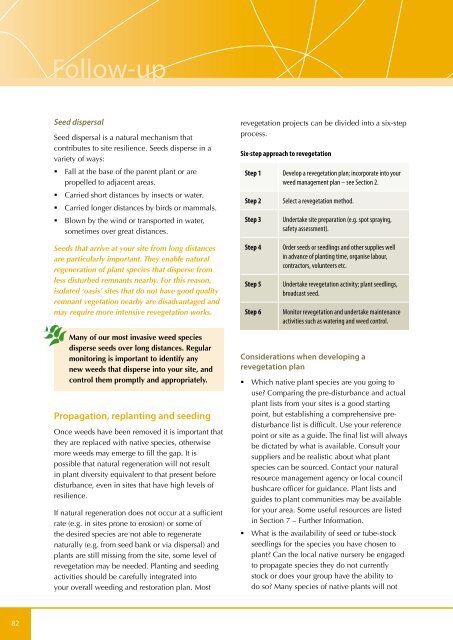Asparagus weeds - Weeds Australia
Asparagus weeds - Weeds Australia
Asparagus weeds - Weeds Australia
- No tags were found...
You also want an ePaper? Increase the reach of your titles
YUMPU automatically turns print PDFs into web optimized ePapers that Google loves.
Follow-upSeed dispersalSeed dispersal is a natural mechanism thatcontributes to site resilience. Seeds disperse in avariety of ways:• Fall at the base of the parent plant or arepropelled to adjacent areas.• Carried short distances by insects or water.• Carried longer distances by birds or mammals.• Blown by the wind or transported in water,sometimes over great distances.revegetation projects can be divided into a six-stepprocess.Six-step approach to revegetationStep 1Step 2Step 3Develop a revegetation plan; incorporate into yourweed management plan – see Section 2.Select a revegetation method.Undertake site preparation (e.g. spot spraying,safety assessment).Seeds that arrive at your site from long distancesare particularly important. They enable naturalregeneration of plant species that disperse fromless disturbed remnants nearby. For this reason,isolated ‘oasis’ sites that do not have good qualityremnant vegetation nearby are disadvantaged andmay require more intensive revegetation works.Step 4Step 5Step 6Order seeds or seedlings and other supplies wellin advance of planting time, organise labour,contractors, volunteers etc.Undertake revegetation activity; plant seedlings,broadcast seed.Monitor revegetation and undertake maintenanceactivities such as watering and weed control.Many of our most invasive weed speciesdisperse seeds over long distances. Regularmonitoring is important to identify anynew <strong>weeds</strong> that disperse into your site, andcontrol them promptly and appropriately.Propagation, replanting and seedingOnce <strong>weeds</strong> have been removed it is important thatthey are replaced with native species, otherwisemore <strong>weeds</strong> may emerge to fill the gap. It ispossible that natural regeneration will not resultin plant diversity equivalent to that present beforedisturbance, even in sites that have high levels ofresilience.If natural regeneration does not occur at a sufficientrate (e.g. in sites prone to erosion) or some ofthe desired species are not able to regeneratenaturally (e.g. from seed bank or via dispersal) andplants are still missing from the site, some level ofrevegetation may be needed. Planting and seedingactivities should be carefully integrated intoyour overall weeding and restoration plan. MostConsiderations when developing arevegetation plan• Which native plant species are you going touse? Comparing the pre-disturbance and actualplant lists from your sites is a good startingpoint, but establishing a comprehensive predisturbancelist is difficult. Use your referencepoint or site as a guide. The final list will alwaysbe dictated by what is available. Consult yoursuppliers and be realistic about what plantspecies can be sourced. Contact your naturalresource management agency or local councilbushcare officer for guidance. Plant lists andguides to plant communities may be availablefor your area. Some useful resources are listedin Section 7 – Further Information.• What is the availability of seed or tube-stockseedlings for the species you have chosen toplant? Can the local native nursery be engagedto propagate species they do not currentlystock or does your group have the ability todo so? Many species of native plants will not82
















